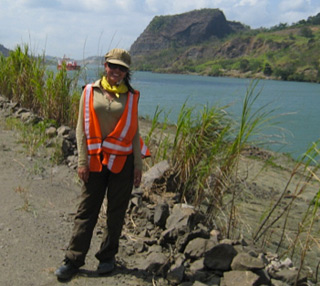By Julia Tejada | PCP PIRE Graduate Student
Our stay in Panama during spring break was a unique and wonderful cultural and scientific experience. Culturally we had the opportunity to be and work in front of a magnificent feat of engineering—the Panama Canal, whose fascinating story intrigued me since I was a child. Our contact with the flora and fauna typical of Panama was memorable as we could observe—and for the first time for most of my teammates—many sloths, agoutis, toucans, alligators, turtles and other wild animals. Having participated in paleontological missions in the Amazon region I had already been in contact with tropical faunas; however, mammals that are hard to observe in the Amazonia were abundant and accessible in Panama.

Regarding the science, our main objective of the trip was finding fossils—vertebrate fossils in particular. At the end of the first day of work in Las Cascadas locality, my first reaction was of appreciation for the efforts made in the past to put together the valuable collection that currently exists because fossils in this locality are difficult to find. Our mission, therefore, was not easy. However, the satisfaction of discovering and being the first to uncover these treasures that were buried for millions of years outweighs the arduous and exhausting days of work and are, without doubt, the payment that every paleontologist is—and should always be—willing to pay. Our effort was pleasantly rewarded with the discovery of interesting and valuable fossils among which we recognized remains of fishes, crocodiles, turtles, dental and bone material of the primitive horses Parahyppus and Anchitherium, and other wonderful surprises that will be studied soon.
In the Gatun formation, we collected teeth of the giant shark Megalodon as well as beautifully preserved invertebrates that will be used for educational purposes. Likewise, it was very rewarding to become aware of the research being conducted at the Smithsonian Tropical Research Institute and meet researchers from all around the world. I was able to nurture and incubate ideas about the evolution of tropical ecosystems.
In short, it was really instructive to visit the localities and geological formations that have yielded such important fossils to science and about which we had heard for some time. Undoubtedly, our trip to Panama was an experience that will stay with us as a fond memory.
Por Julia Tejada | Estudiante de maestría PCP PIRE
Nuestra estadía en Panamá el pasado Spring break fue una experiencia cultural y científica única y maravillosa. Culturalmente tuvimos la oportunidad de estar y trabajar frente a la majestuosa obra de ingeniería que es el Canal de Panamá, cuya fascinante historia me intrigó desde muy chica. Nuestro contacto con la fauna y flora típica de Panamá fue inolvidable pues pudimos presenciar –y por vez primera para la mayoría de mis compañeros—numerosos perezosos, agutíes, tucanes, caimanes, tortugas y muchos otros animales salvajes. Habiendo realizado misiones paleontológicas en la región amazónica, había estado ya en contacto con faunas tropicales, sin embargo, aquellos mamíferos tan difíciles de observar naturalmente en la Amazonia eran muy abundantes y accesibles en Panamá.

Respecto a lo científico, nuestro objetivo primordial durante el viaje fue la búsqueda de fósiles… y fósiles de vertebrados en particular. Al final de nuestro primer día de trabajo en la localidad Las Cascadas, mi primera reacción fue de reconocimiento al esfuerzo realizado en años anteriores para formar la valiosa colección que existe actualmente, pues los fósiles en esta localidad no son fáciles de encontrar. Nuestra misión, consecuentemente, no fue sencilla. Sin embargo, la satisfacción de descubrir y ser los primeros en develar estos tesoros que permanecieron enterrados por millones de años compensan con creces los arduos y extenuantes días de trabajo y constituyen, sin duda alguna, el pago que todo paleontólogo siempre está—y debe siempre estar—deseoso de pagar. Nuestro esfuerzo fue gratamente recompensado con el hallazgo de interesantes y valiosos fósiles entre los que pudimos reconocer restos de peces, cocodrilos, tortugas, materiales dentarios y óseos de los caballos primitivos Parahyppus y Anchitherium, así como otras maravillosas sorpresas que serán próximamente estudiadas.
En la formación Gatún, colectamos dientes del tiburón gigante Megalodon así como numerosos invertebrados hermosamente preservados que serán utilizados con fines didácticos para incentivar el interés por la ciencia en escolares. Así mismo, el ser partícipe de las investigaciones que se realizan en el Instituto Smithsonian de Investigaciones Tropicales y conocer investigadores de todas partes del mundo fue muy enriquecedor pues me permitió nutrir e incubar ideas sobre la evolución de los ecosistemas tropicales.
En definitiva, fue muy instructivo conocer las localidades y formaciones geológicas que tan importantes fósiles han dado al conocimiento y de las cuales habíamos escuchado hablar desde hacía tiempo. Sin duda alguna, nuestro viaje a Panamá constituye una experiencia que permanecerá en nuestra memoria bajo un grato recuerdo.